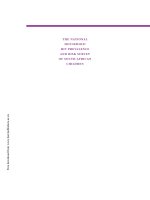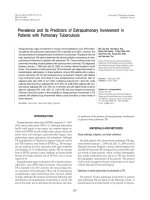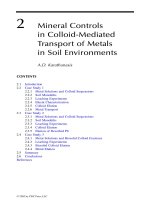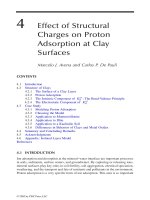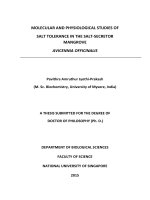Prevalence and molecular detection of blood protozoa in domestic pigeon
Bạn đang xem bản rút gọn của tài liệu. Xem và tải ngay bản đầy đủ của tài liệu tại đây (534.91 KB, 11 trang )
Int.J.Curr.Microbiol.App.Sci (2019) 8(5): 1426-1436
International Journal of Current Microbiology and Applied Sciences
ISSN: 2319-7706 Volume 8 Number 05 (2019)
Journal homepage:
Original Research Article
/>
Prevalence and Molecular Detection of Blood Protozoa in Domestic Pigeon
Munmi Saikia1*, Kanta Bhattacharjee1, Prabhat Chandra Sarmah1, Dilip Kr. Deka1,
Shantanu Tamuly2, Parikshit Kakati1 and Pranab Konch3
1
Department of Parasitology, 2Department of Biochemistry, 3Department of Pathology,
College of Veterinary Science, Khanapara, Guwahati-781022, Assam, India
*Corresponding author
ABSTRACT
Keywords
Pigeon,
Haemoprotozoa,
Prevalence, PCR,
Assam
Article Info
Accepted:
12 April 2019
Available Online:
10 May 2019
The present study was carried out to know the status of haemoprotozoan infection of
domestic pigeon in Assam by microscopic examination of blood of pigeons for a period of
one year which revealed an overall prevalence of 53.39%. Three species viz.
Haemoproteus columbae (29.93%), Plasmodium relictum (21.29%) and Leucocytozoon sp.
(2.16%) were identified either in single or mixed infection. According to age, highest
prevalence was recorded in adult (61.81%) and lowest in squab (36.25%). Comparatively,
infection was recorded higher in females (58.22%) than males (48.79%). Season wise,
infection was recorded highest during Pre-monsoon (72.22%) and lowest during Postmonsoon. Amplification of cyt b gene of Haemoproteus columbae in positive samples by
PCR showed clear band at 207 bp. Amplification of mt- cyt b gene of Haemoproteus spp.
and Plasmodium spp. by PCR on positive samples revealed clear band at 525 bp.
Introduction
Species of apicomplexan Haemoproteus,
Plasmodium and Leucocytozoon are well
known genera of avian haematozoa and
comprise a diverse group of vector
transmitted parasites.
They are closely related genetically but
different in life history traits (Valkiunas,
1993). Avian malaria, caused by Plasmodium
sp. is transmitted to birds by mosquitoes and
has a long-term effect on the reproductive
system of the host causing population
decrease
(Lapointe
et
al.,
2012).
Leucocytozoon sp. typically causes anaemia
and enlargement of liver and spleen (Dey et
al.,
2010).
Haemoproteus
columbae
commonly infect pigeon and doves and is
widely distributed in tropical and subtropical
regions and transmitted by blood sucking
hippoboscid fly Pseudolynchia canariensis.
Its pathogenicity is generally low; however,
due to acute infections in severely affected
young pigeon heavy mortality is seen (Dey et
al., 2010).
1426
Int.J.Curr.Microbiol.App.Sci (2019) 8(5): 1426-1436
Materials and Methods
Study period
The present study was undertaken to ascertain
the haemoprotozoan infection in domestic
pigeon (Columba livia domestica) for a period
of one calendar year w.e.f. February 2015 to
January 2016.
Sample collection
Four districts of Assam namely Kamrup
Rural, Kamrup Metro, Lakhimpur and
Dhemaji formed the study areas. Blood
samples of pigeons were collected from
different households, market places and
temple premises.
The pigeons were categorized according to
age viz. squab (< 30 days), young (30-90
days) and adult (> 90 days) and sex (male and
female). The study period was divided into
four seasons viz. Pre-monsoon (March, April,
May), Monsoon (June, July, August,
September),
Post-monsoon
(October,
November) and Winter (December, January,
February).
Sampling of Blood
Haemoprotozoa
for
Detection
of
Blood samples from 324 live pigeons were
collected from wing vein using a 2 ml
disposable syringe in EDTA vials and brought
to the laboratory for parasitological and
molecular analysis. For molecular analysis,
the anticoagulated blood was stored in deep
freeze at –20 ºC until further use thin blood
smears were prepared using commercial
Giemsa stain and examined under high power
(40X) and oil immersion objective (100X) of
light
microscope
for
detection
of
Haemoproteus sp. and Plasmodium sp. inside
the red blood cells and Leucocytozoon sp.
inside the lymphocytes and monocytes. The
parasites were identified on the basis of their
characteristic morphology (Levine, 1977;
Soulsby, 1982) and percent parasitaemia (No.
of parasitized cell /Total no. of respective cell
x 100 = % parasitaemia) in positive cases
were estimated
Molecular
columbae
detection
of
Haemoproteus
DNA was extracted from 30 random positive
samples of blood using DNeasy Blood and
Tissue Kit (Qiagen Germany) as per
manufacture’s guidelines. The extracted DNA
was stored at -20º C until further use. The
PCR was performed following the method of
Doosti et al., (2014) to amplify a segment of
cyt b gene of Haemoproteus columbae using
oligonucleotide primer (H. clom- F 5′-TTA
GAT ACA TGC ATG CAA CTG GTG-3′and
H. clom-R 5′-TAG TAA TAA CAG TTG
CAC CCC AG-3′) in 25µl reaction mixture
containing 1µl DNA template, 1µl (20 pmol/
µl) of each forward and reverse primer, 1µl
MgCl2 (50 mM), 0.5µl dNTPs mix (10 mM),
0.25µl Taq DNA polymerase (5 IU/ µl) and
the remaining volume adjusted with nuclease
free water. PCR amplification was performed
in a Technee-5000 thermal cycler (Bibby
Scientific). PCR was performed with Initial
denaturation at 94˚C for 5 min followed by 30
cycles consisting of denaturation at 94˚C for 1
min, annealing at 60º C for 1 min, extension
at 72˚C for 1 min and final extension at 72˚C
for 5 min. A negative control consisting of a
reaction mixture without the DNA was used.
Molecular detection of Haemoproteus spp.
and Plasmodium spp.
DNA was extracted from 10 random positive
blood
samples
of
pigeons
having
simultaneous infection of Haemoproteus
columbae and Plasmodium relictum on blood
smear examination using DNeasy Blood and
Tissue Kit (Qiagen Germany). PCR was
1427
Int.J.Curr.Microbiol.App.Sci (2019) 8(5): 1426-1436
performed following the method described by
Valkiunas et al., (2008) with little
modification to amplify a segment of
mitochondrial cyt b gene of Haemoproteus
spp.
and
Plasmodium
spp.
using
oligonucleotide primers (Haem F 5′ATGGTGCTTTCGATATATGCATG-3′ and
(HaemR2
5′GCATTATCTGGATGTGATAATGGT-3′).
PCR amplification was done in a Technee5000 thermal cycler (Bibby Scientific) in 25µl
reaction mixture containing 5 µl of genomic
DNA, 2.5 µl 10x PCR buffer, 1.0 µl MgCl2
(50 mM), 0.5 µl dNTP (10 mM), 1.0 µl (20
pmol/ µl) of each forward and reverse primer,
0.2 µl Taq DNA polymerase (5 IU/ µl) and
nuclease free water up to 25 µl. PCR
amplification was done with initial
denaturation at 94˚C for 3 min, and then 35
cycles consisting of denaturation for 30 sec at
94˚C, annealing for 30 sec at 50˚C and
extension for 45sec at 72˚C, followed by final
extension at 72˚C for 10 min. A negative
control consisting of a reaction mixture
without the DNA template was taken.
Electrophoresis
For visualization of the PCR product, gel
electrophoresis of amplified DNA was done
in 1.5 % agarose gel for 1 hour at 5 Volts per
cm using 1 X Tris Acetate EDTA (1X TAE)
running buffer. Four µl of the PCR product
mixed with 3 µl of gel loading dye (6X DNA
Loading Dye, Fermentas) was loaded on to
the gel with standard markers (100 bp DNA
ladder, Fermentas). The gel was then stained
with ethidium bromide (0.5 µg/ ml) and
visualized under gel doc (DNR Bio-Imaging
System, Mini Lumi) for the expected product
size and images were obtained.
Statistical analysis
Chi-square test was used for statistical
analysis of the prevalence data using SAS
v.20 software.
Results and Discussion
Prevalence of haemoprotozoa according to
parasite species
Species wise, prevalence of Haemoproteus
columbae was 29.93%, Plasmodium relictum
21.29% and Leucocytozoon sp. 2.16% (Table
1 and Fig. 1) without significant statistical
difference (P<0.05).
Prevalence of H. columbae ranging from 15
to 80% was reported by several workers (18%
by Ishtiaq et al., 2007 from India; 22% by
Valkiunas et al., 2008; 47.05% by Radfar et
al., 2011 from Iran; 60% by Roy et al., 2011
from Assam; 69.09% by Varshney et al.,
2014 from Surat; 74.28% Borkataki et al.,
2015 from Jammu). Report of 28%
prevalence by Abed et al., (2014) from Iraq is
in agreement with our findings. Studies to
date have reported that the most common
blood parasite found in pigeons is H.
columbae, usually considered to be non pathogenic but may cause disease in stressed
pigeons. The variation in prevalence rate of
this parasite in different countries might be
influenced by geographical region, vector
abundance, host genotype, host size, age or
sex of host, feeding habitats, health status of
bird etc.
Prevalence of Plasmodium relictum (27.5%)
similar to our findings was reported from
Kamakhya premises, Assam by Roy et al.,
(2011) and Gupta et al., (2011) from Uttar
Pradesh (6.76%). This finding substantiates
that mosquito of Genus Culex, the vector of
pigeon malaria is commonly prevalent in
Assam.
Prevalence of Leucocytozoon sp. in the
present finding is similar to the report of 2%
by Nath et al., (2014) from Bangladesh.
However, higher prevalence has been
reported by several workers (6.4% by Natala
1428
Int.J.Curr.Microbiol.App.Sci (2019) 8(5): 1426-1436
et al., 2009; 20% by Dey et al., 2010 and 25%
by Valkiunas et al., 2008) which contradict
our findings and possibly it might be due to
study made in different environments,
population of vector fly and number of birds
examined. In the present study, prevalence of
mixed infection of Haemoproteus columbae
and Plasmodium relictum was recorded as
7.71%. Beadell et al., (2009) similarly
reported 6.8% pigeons in the Australo-Papuan
region. Contrary to our finding, slightly lower
prevalence (2.67%) was reported by Jahan et
al., (2011) from Uttar Pradesh. Co-infection
with two or more parasites revealed that the
presence of one haemoparasite predisposes to
other haemosporidian infections. Our finding
agrees with the above statement. There was a
noticeable
relationship
between
the
prevalence of H. columbae (29.93%) and its
vector, Pseudolynchia canariensis (15.12%).
The closeness in their percentage prevalence
suggests that most of the vector harboured by
the pigeons were probably carrying
pathogens. According the Taylor et al.,
(2007), the presence of Plasmodium and
Leucocytozoon in the blood of the pigeons
was an indication of the presence of Culex
and Simulium respectively, as they are
established vectors of these haemoparasites.
In our study of haemoprotozoa, the mean
concentration of parasites was 1-6 pars/100
RBC for both H. columbae and P. relictum
with variation in the shape and size of the
gametocytes (Fig. 5). Similar reports were
made (Gupta et al., 2011; Jahan et al., 2011
and Hussein et al., 2016) from India and
elsewhere.
Age wise prevalence of haemoprotozoan
parasites
The present finding recorded 61.81%
prevalence of haemoprotozoa in adult
followed by young (56.71%) and squab
(36.25%) (Table 2 and Fig. 2) with statistical
significance (P<0.05). Our report conform
that of Momin et al., (2014) from Bangladesh
who stated that adults were 6.89 times more
susceptible than young birds. Msoffe et al.,
(2010) from Tanzania also made identical
report. It is apprehended that adult birds are
generally more attacked by vector flies.
Sex wise prevalence of haemoprotozoa
parasites
Sex wise, prevalence was recorded more in
female (58.22%) than the male (48.71%)
(Table 3, Fig. 3) with non-significant
(P>0.05) difference and agreeing with the
findings of Momin et al., (2014). However,
several workers from abroad (Dey et al.,
2010; Opara et al., 2012 and Hussein et al.,
2016) recorded higher prevalence in male
than female. Though the exact cause of higher
infection in females could not be explained it
was assumed due to higher level of prolactin
and progesterone suppressing the immune
system of the individual and making the
female more susceptible to any infection.
Seasonal prevalence of haemoprotozoa
Haemoprotozoan infection was recorded
highest during Pre-monsoon season (72.22%)
and lowest during Post monsoon, however,
infection was more or less present throughout
the year (Table 4 and Fig. 4). It might be due
abundance of vector in Pre monsoon season.
Literature is scant leading to less information
on this aspect.
Molecular
columbae
detection
of
Haemoproteus
PCR employed for molecular detection of H.
columbae by amplification of cyt b gene
showed clear band at 207 bp (Fig. 6a) similar
to the work of Doosti et al., (2014) who
reported 23.18% prevalence of H. columbae
in 220 pigeons in Iran.
1429
Int.J.Curr.Microbiol.App.Sci (2019) 8(5): 1426-1436
Table.1 Species-wise prevalence of haemoprotozoa in pigeon
Parasite species
Single
infection
No. (%)
69
(21.29)
44
(13.58)
4
(1.23)
117
(36.11)
Haemoproteus
columbae
Plasmodium
relictum
Leucocytozoon
sp.
Overall
Sample examined (n=324)
Mixed infection
No. (%)
H. columbae
P. relictum
Leucocytozoon sp.
25
3
(7.71)
(0.92)
25
0
(7.71)
(0.0)
3
0
(0.92)
(0.0)
28
25
3
(8.64)
(7.71)
(0.92)
Total
No. (%)
97
(29.93)
69
(21.29)
7
(2.16)
173
(53.39)
Chisquare
value
23.6716*
*P(<0.05)
Table.2 Age wise prevalence of haemoprotozoan parasites in pigeon
Age group
(No.
examined)
Squab (80)
(< 30 days)
Young (134)
(30-90 days)
Adult (110)
(>90 days)
Total (324)
Haemoproteus
columbae
No. positive (%)
15
(18.75)
46
(34.32)
36
(32.72)
97
(29.93)
Parasite Prevalence
Plasmodium
Leucocytozoon
relictum
sp.
No. Positive (%) No. Positive(%)
14
0
(17.50)
(0.0)
26
4
(19.40)
(2.98)
29
3
(26.36)
(2.72)
69
7
(21.29)
(2.16)
Total
No. (%)
29
(36.25)
76
(56.71)
68
(61.81)
173
(53.39)
Chisquare
value
24.6516*
* P(<0.05)
Table.3 Sex-wise prevalence of haemoprotozoan parasites in pigeon
Sex
No.
examined
Male
166
Female
158
Total
324
NS
Haemoproteus
columbae
No. Positive (%)
42
(25.30)
55
(34.81)
97
(29.93)
Plasmodium
relictum
No. positive (%)
36
(21.68)
33
(20.88)
69
(21.29)
(Non significant), P>0.05
1430
Leucocytozoon
sp
No. positive (%)
3
(1.80)
4
(2.53)
7
(2.16)
Total
No. positive (%)
81
(48.79)
92
(58.22)
173
(53.39)
Chisquare
value
1.3215NS
Int.J.Curr.Microbiol.App.Sci (2019) 8(5): 1426-1436
Table.4 seasonal prevalence of haemoprotozoa in pigeon
Month/season
Premonsoon (March,
April, May)
Monsoon (June, July,
August, September)
Post
monsoon
(October, November)
Winter (December,
January, February)
Total
Samples screened
for haemoprotozoa
90
78
56
100
324
Sample positive for
haemoprotozoa
(%)
65
(72.22%)
36
(46.15)
30
(53.57)
42
(42.0)
173
(53.39)
Chisquare
value
6.7118NS
NS
(Non-significant) P(>0.05)
Fig.1 Species-wise prevalence of haemoprotozoa in pigeons
Leucocytozoon sp.
1431
Int.J.Curr.Microbiol.App.Sci (2019) 8(5): 1426-1436
Fig.2 Age-wise prevalence of haemoprotozoa in pigeons
Fig.3 Sex-wise prevalence of haemoprotozoan parasites in pigeon
Fig.4 Seasonal prevalence of haemoprotozoa in pigeon
1432
Int.J.Curr.Microbiol.App.Sci (2019) 8(5): 1426-1436
Fig.5 Immature stages (gametocytes) (a-b), mature gametocytes (c-f), of Haemoproteus
columbae; mature gametocytes (g-h), of Plasmodium relictum 1000X (Oil immersion)
b
a
c
d
e
g
f
h
1433
Int.J.Curr.Microbiol.App.Sci (2019) 8(5): 1426-1436
Fig.6 (a) PCR product at 207 bp of Haemoproteus columbae ( L-Ladder 100 bp, Lane-1, 2, 3, 4,
5, 6 & 8- positive sample, 7- Negative control) & b) PCR product at 525 bp of Haemoproteus
and Plasmodium ( L-Ladder:100 bp, Lane-1, 2 , 3, 4 & 5 -positive samples and 6-Negative
control)
L 1
2
3
4
5
6
7
8
207bp
1
L
2
3
4
5
6
525 bp
Molecular detection of Haemoproteus spp.
and Plasmodium spp.
PCR employed for simultaneous detection of
H. columbae and P. relictum by amplification
of mt-cyt b gene revealed clear band at 525 bp
(Fig.6b). In our present study, by microscopic
examination some early developmental stages
of Haemoproteus columbae and Plasmodium
relictum could not be morphologically
differentiated, especially in mixed infection.
However, it was confirmed by PCR.
Similarly, Hellgren et al., (2004) opined that
by conventional microscopy, especially in
chronic infections, species of Haemoproteus
might be difficult to distinguish from avian
1434
Int.J.Curr.Microbiol.App.Sci (2019) 8(5): 1426-1436
species of Plasmodium. Several PCR-based
methods for studies of Haemoproteus spp.
and Plasmodium spp. have been reported
(Bensch et al., 2000; Richard et al., 2002;
Bell et al., 2015). Similarly, Hellgren et al.,
(2004) and Bell et al., (2015) described a
Nested PCR assay targeting the cyt b gene of
the parasites, for screening and typing of
Leucocytozoon sp. in parallel with
Haemoproteus and Plasmodium in avian
blood samples. From the present study, it was
found that 53.39% pigeon were infected with
three types of blood protozoa such as
Haemoproteus
columbae
(29.93%),
Plasmodium
relictum
(21.29%)
and
Leucocytozoon sp. (2.16%). It may be
concluded that the protozoan infections in
pigeon are highly endemic in Assam. The
systematic study conducted for the first time
in Assam led to a significant conclusion that
favourable climatic condition and presence of
vectors are the contributing factors towards
prevalence of haemoprotozoan parasites.
Acknowledgement
The authors are thankful to the Dean, College
of Veterinary Science, Assam Agricultural
University for providing the necessary
facilities to conduct the study.
References
Beadell, J.S., Covas, R., Gebhard, C., Ishtiaq,
F., Melo, M. and Schmidt, B.K. 2009. Host
associations and evolutionary relationships
of avian blood parasites from West Africa.
International Journal of Parasitology. 39:
257-266.
Bell, J. A., Weckstein, J. D., Fecchio, A. and
Tkach, V.V. 2015. A new real- time PCR
protocol
for
detection
of
avian
haemosporidians. Parasites & Vectors.
8:383.
Bensch, S., Stjernman, M., Hasselquist, D.,
Ostman, O., Hansson, B., Westerdahl, H.
and Pinheiro, R.T. 2000. Host specificity in
avian blood parasites: a study of
Plasmodium
and
Haemoproteus
mitochondrial DNA amplified from birds.
Proceedings of the Royal Society of
London. 267:1583-1589.
Borkataki, S., Katoch, R., Goswami, P., Godara,
R., Khajuria, J. K., Yadav, A., Kour, R. and
Mir, I. 2015. Incidence of Haemoproteus
columbae in pigeons of Jammu district.
Journal of Parasitic Diseases. 39 (3): 426428.
Dey, A.R., Begum, N., Paul, S.C., Noor, M. and
Islam, K.M. 2010. Prevalence and
pathology of blood protozoa in pigeons
reared at Mymensingh district, Bangladesh.
International Journal of Biological
Research. 2 (12): 25-29.
Doosti, A., Ahmadi, R., Mohammadalipour, Z.
and Zohoor, A. 2014. Detection of
Haemoproteus columbae in Iranian pigeons
using PCR. International Conference on
Biological, Civil and Environmental
Engineering. March 17-18, Dubai (UAE).
Gupta, D.K., Jahan, N. and Gupta, N. 2011.
New records of Haemoproteus and
Plasmodium (Sporozoa: Haemosporida) of
rock pigeon (Columba livia) in India.
Journal of Parasitic Diseases. 35(2):155–
168.
Hellgren, O., Waldenstrom, J. and Bensch, S.
2004. A new PCR for simultaneous studies
of Leucocytozoon, Plasmodium and
Haemoproteus from avian blooid. Journal
of Parasitology. 90 (4): 797-802.
Hussein, M.N. and Abdelrahim, A. E. 2016.
Haemoproteus
columbae
and
its
histopathological effects on Pigeons in
Quena Governorate, Egypt. IOSR Journal
Pharmacy and Biological Sciences (IOSRJPBS). 11(1):79-90.
Ishtiaq, F., Gering, E., Rappole, J. H., Rahmani,
A. R., Jhala, Y.V., Dove, C.J., Milensky,
C., Olson, S. L., Pierce, M.A. and
Fleischer, R. C. 2007. Prevalence and
diversity of avian haematozoan parasites in
Asia: A regional survey. Journal of
Wildlife Diseases. 43(3): 382-398.
Jahan, N., Chandra, R. and Shoeb, M. 2011.
Parasitimic load of haematozoan parasites
1435
Int.J.Curr.Microbiol.App.Sci (2019) 8(5): 1426-1436
in Rock pigeons (Columba livia). Recent
Research in Science and Technology. 3(6):
9-11.
Lapointe, D.A., Atkinson, C.T. and Samuel,
M.D. 2012. Ecology and conservation
biology of avian malaria. Annals of the
New York Academy of Sciences. 1249: 211226.
Levine, N.D. 1977. Textbook of Veterinary
Parasitology.
Burgess
Publishing
Company, USA.
Momin, M. A., Begum, N., Dey, A. R., Paran,
M. S. and Alam, M. Z. 2014. Prevalence of
blood protozoa in poultry in Tangail,
Bangladesh. IOSR Journal of Agriculture
and Veterinary Science. 7(7): 55-60.
Msoffe, P. L. M., Muhairwa, A. P., Chiwanga,
G. H. and Kassuku, A. A. 2010. A study of
ecto- and endoparasites of domestic
pigeons in Morogoro Municipality,
Tanzania. African Journal of Agricultural
Research. 5 (3):264-267.
Natala, A.J., Asemadahun, N.D., Okubanjo,
O.O. and Ulayi, B.M. 2009. A survey of
parasites of domesticated pigeon (Columba
livia domestica) in Zaria, Nigeria.
International Journal of Soft Computing. 4
(4): 148-150.
Nath, T. C., Bhuiyan, M. J. U. and Alam, M. S.
2014. A study on the presence of
leucocytozoonosis in pigeon and chicken of
hilly districts of Bangladesh. Issues in
Biological Sciences and Pharmaceutical
Research. 2 (2):013-018.
Opara, M. N., Ogbuewu, I. P., Njoku, L., Ihesie,
E.K. and Etuk, I.F. 2012. Study of the
haematological and biochemical values and
gastrointestinal and haemoparasites in
racing pigeons (Columba livia) in Owerri,
Imo State, Nigeria. Revista Cientifica UDO
Agricola.12(4):955-959.
Radfar, M.H., S, Fathi., Asl, E. N., Dehaghi,
M.M. and Seghinsara, H.R. 2011. A survey
of parasites of domestic pigeons (Columba
livia domestica) in South Khorasan.
Iranian Journal of Veterinary Research.
4(1):18-23.
Richard, F.A., Sehgal, R. N. M., Jones, H. I.
and Smith, T.B. 2002. A Comparative
Analysis of PCR-Based Detection Methods
for Avian Malaria. Journal of Parasitology.
88 (4):819-822.
Roy, K., Bhattacharjee, K. and Sarmah, P. C.
2011. Prevalence of endoparasites in
pigeons.
Journal
of
Veterinary
Parasitology. 25: 94-95.
Soulsby, E.J.L. Helminths, Arthropods and
Protozoa of Domesticated Animals.
Seventh Edition, The English Language
Book Society and Baillier Tindal and
Cassel Ltd., London. 2012; 367-370, 440441.
Taylor, M.A., Coop, R.L. and Wall, R. L.
2007.Veterinary Parasitology. 3rdEdn. Publ.
Blackwell Ltd. Oxford. 1-874.
Valkiunas, G. 1993. Pathogenic influence of
haemosporidians and trypanosomes on
wild Birds in the field conditions. Facts and
hypothesis. Ecologija. 1:47-60.
Valkiunas, G., Lezhova, A.T., Krizanauskiene,
A., Palinauscas, V., Sehgal, N.M. R. and
Bensch, S. 2008. A comparative analysis of
microscopy and PCR- based detection
methods for blood parasites. Journal of
Parasitology. 94(6): 1395-1401.
Varshney, J. P., Deshmukh, V.V. and
Chaudhury, P. S. 2014. Pseudomalaria
(Haemoproteus columbae) in Pigeon
Shelter. Intas Polivet. 15 (1):176-177.
How to cite this article:
Munmi Saikia, Kanta Bhattacharjee, Prabhat Chandra Sarmah, Dilip Kr. Deka, Shantanu
Tamuly, Parikshit Kakati and Pranab Konch. 2019. Prevalence and Molecular Detection of
Blood Protozoa in Domestic Pigeon. Int.J.Curr.Microbiol.App.Sci. 8(05): 1426-1436.
doi: />
1436

